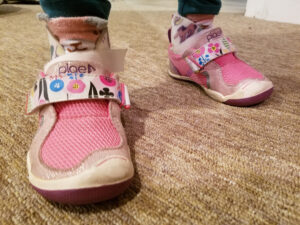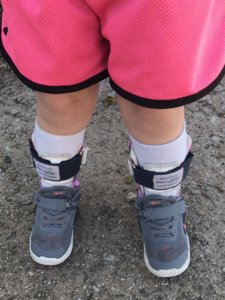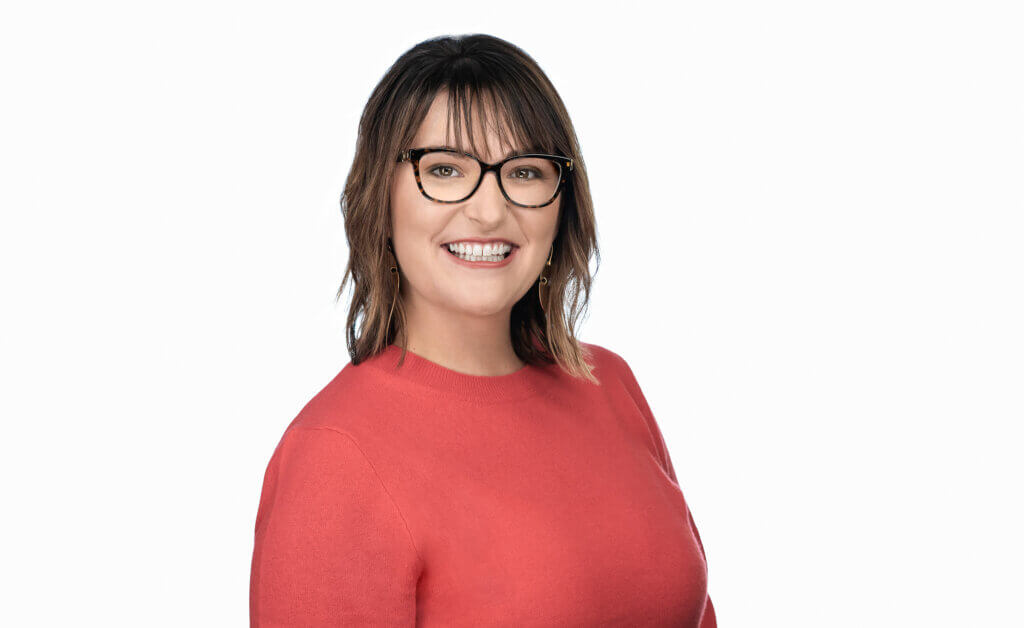By Yosef Travis
Our daughter has this little game she likes to play. It’s actually a game her grandfather plays with all of his grandchildren, but she really loves it. Essentially, the adult uses their fingers to walk along the abdomen while singing “These Boots Are Made for Walking” (Nancy Sinatra). Just before “these boots will walk all over you”, the adult pauses to build anticipation and then hurriedly says the last line while tickling the baby. Uproarious laughter ensues.
JS parents are keenly aware of how rarely boots (and shoes) are actually made for walking. From the moment our children begin to develop any sort of leg strength (and sometimes before), we begin to think about footwear. However, the requirements for JS kids’ footwear are often different than those for non-JS kids.
Case in point. Our daughter’s PT wanted her to have shoes to help give her more support and confidence while they did standing exercises together. We went to a specific shoe store because it had a reputation for knowing how to properly fit children with physical disabilities. The staff there tried to convince us that we should take a soft first walker shoe. The kind you can bend in half with one hand. Luckily our PT took our call on a Sunday, so we were able to confirm with him that she needed rugged durable footwear, not cutesy first walker shoes.
In the Joubert Syndrome Support Facebook group, questions about finding proper shoes are common, but they essentially boil down to two questions. Some parents are concerned with finding supportive shoes for toddlers and school age children to allow for weight bearing and gait training. Other parents are concerned with finding (stylish) shoes to fit over Ankle-Foot Orthoses (AFOs) or Supramalleolar Orthoses (SMOs).
Choosing Supportive Shoes
The quest for supportive shoes is not confined to parents of JS kids, so the options are more varied. A few general tips from pediatricians (and paediatricians) are outlined below:
– Shoes should be well-made with non-skid soles.
– Shoes should be sturdy enough to protect the whole foot on smooth and rough surfaces.
– Shoes should fit snugly at the heel.
– Shoes should have approximately 1 finger’s width of space between the big toe and the front of the shoe while child is standing. This should be rechecked monthly.
-American Academy of Pediatrics & Canadian Paediatric Society
Choosing Compatible Shoes
Finding shoes to wear with orthoses is much more complex and a lot will depend on the individual’s gait and mobility needs. The American Physical Therapy Association provides some general guidelines, but choosing the right pair of shoes will require trial and error, as well as conversations with physical and/or occupational therapists. Some of the guidelines from the APTA are:
– Shoes should be well made with a quality sole and heel counter (the hard material on the back part of the shoe).
* Note: You can test the heel counter by attempting to bend the shoe at the heel. A solid heel counter will not bend.
– Shoes should have a removable insole to allow increased instep depth, if necessary.
– Heel should be 1/4 to 3/8 of an inch high.
– Shoe should have a real closure device (e.g. laces or Velcro).
Most importantly, the APTA advises that an experienced orthotist or similar clinician assist with the selection and fitting of a shoe to ensure proper fit with an orthosis.
Bearing all that in mind, the following are some of the most popular shoes suggested by parents of JS kids.
BILLY Footwear
BILLY Footwear is a company that prides itself on making a shoe that looks good and goes on smoothly too. According to the company, every shoe, “incorporates zippers that go along the side of the shoes and around the toe, allowing the upper of each shoe to open and fold over completely.” This unique feature makes putting on shoes easier for those with difficulty tying laces.
The top choice for many parents is the BILLY Classic Lace High Kid’s Canvas Zip (retailing at approximately $55 USD and available in sizes from 10 Toddler to 6 Big Kid). The shoe has a removable insole and a non-slip bottom. The company claims that the shoes fit with AFOs and many parents agree. Some parents have had success with SMOs, as well.
The company plans on introducing young adult and adult sizes in the near future, as well as allowing customers to choose wide shoes instead of only standard width. This may make it easier for those with larger braces.
Pro tip: Buy the shoes in a range of sizes around the actual foot size to see which works best with a particular orthosis. Be sure to use retailers with free return shipping!


PLAE
Some parents are big fans of the PLAE Kids Max high top (retailing at approximately $59 USD and available in sizes from 8 Toddler to 4 Big Kid). The shoes have a non-slip bottom and are durable. The shoes have a Velcro closure, but the Velcro tabs can be swapped out for different patterns. This gimmick has enabled parents to substitute the Velcro tabs for longer tabs (one parent sewed two tabs together) to fit the shoes over AFOs.
PLAE has recognized the appeal of some of their shoes to orthosis users and created the Adaptive Friendly section of its website. Users can browse shoes promoted for use with orthoses, read helpful hints from other parents, and download a size guide to ensure a proper fit.


Nike
Nike shoes are often valued for the company’s attention to comfort and ease of use, while maintaining a signature style. However, they tend to be a bit pricey.
FlyEase technology from Nike was inspired by Matthew Walzer and his battle with cerebral palsy. The technology involves a wrap around zipper that opens the shoe near the heel and allows for the shoe to be easily slid on and off. The technology was added to several shoes including the LeBron Soldier 11 FlyEase (retailing for approximately $80 and available in sizes from 10.5 Children to 7 Youth). Some of the styles are limited editions and may not be available for long.


Ultimately, the shoe that works for one individual may not be the right choice for another individual. The decision about any footwear should be made in consultation with appropriate therapists and clinicians. Hopefully, the information and tips included here will help parents of JS kids in selecting from the myriad footwear options available for purchase. Remember, whether your kids are ready to dance to Nancy Sinatra or just starting to test their legs, the right shoes can make all the difference!

